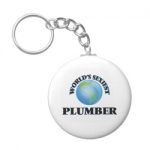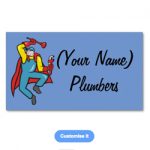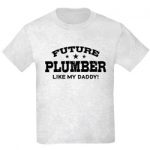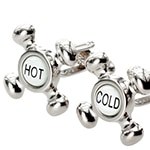Most plumbers would keep this stuff schtum but we believe in honesty.
These are the six things your plumber won’t tell you.
- Monday is our busiest day
It’s when we get calls from frantic customers whose significant other has messed up the plumbing during a weekend DIY job! - How to locate the stopcock
Would you know how to turn off the water supply in an emergency? We’ll help you find the stopcock and show you how to operate it – after all, it could be all that’s standing between you and a flooded home. - Buy a drain strainer or hair snare
Hair is one of the prime suspects in many blocked shower drain cases. Using a hair snare, or even just wiping loose strands out of the plughole after use, can save you a lot of trouble. - Flushable wipes are not really flushable
They just don’t break down fast enough like regular toilet paper does. So please, chuck them in the bin to avoid a blocked loo. - A dripping tap can waste enough water to fill a bath every day1
Each drip may seem insignificant to you now, but if you don’t get a leaky shower or tap seen to sooner rather than later, you’ll pay for it by the time the water bill comes. - Quality may come at a slightly higher price
Too often, under qualified plumbers reel customers in with cheap prices and then end up charging them more in call-back fees when something goes wrong. By choosing a plumbing company with a reputation for good work carried out by professional engineers, you may pay a little more upfront but it’s likely to save you money and stress in the long run.
1 South Staffs Water, 2015. Tips – inside your home. [Online] Available at: http://www.south-staffs-water.co.uk/your_home/indoor_water_saving_tips.asp. [Accessed 27th February 2015].
Ever wonder what the world was like before multi-feature Japanese toilets? We bring you a brief history of plumbing.
Origins
Plumbing originated in ancient Greek, Roman, Persian, Indian and Chinese civilisations as the cities began to develop public baths and needed to provide potable water and safe wastewater removal for growing numbers of people.
Earthen pipes with broad flanges made of asphalt to prevent leaks appeared in urban settlements of the Indus Valley Civilisation by 2700 B.C. and the Romans used lead pipe inscriptions to deter water theft.
The Roman apex
Plumbing reached an early peak in ancient Rome, which saw the creation of aqueducts, tile wastewater removal and the widespread use of lead pipes.
However, when the Roman Empire fell, as did the plumbing glory days, and Rome’s water supply stagnated for over 1,000 years.
The 1800s
In the 1800s, public health authorities called for better waste disposal systems in a bid to control disease epidemics.
Prior to this, waste was simply collected and dumped into the streets or the river, but the new rules introduced the development of separate, underground water and sewage systems.
Finally, open sewage ditches and cesspools could become a distant memory.
Our modern plumbing systems
Today, most large cities pipe solid wastes to sewage treatment plants to partially purify water before it is sent into streams.
After World War II, the use of lead pipes in public water supplies sharply declined due to increased awareness of the dangers of lead poisoning, and today copper piping is used as a safer alternative.
When you call out a local plumber, you want to know exactly what they’re quoting you for.
Use our quick plumbing glossary to get up to speed.
STD – standard
Saddle tee – fitting that taps into the side of a pipe to make a quick connection to an existing line
Saddle valve – a valve mounted on a pipe run by a clamping device or saddle tee to supply water for a low-demand device
Safety shutoff valve – a device on a gas appliance that shuts off the gas supply to prevent a hazardous situation
Sag pipe – a section of a sewer line that is placed deeper in the ground than normal to pass under utility piping, waterways, rail lines, highways or other obstacles
Saponification –the process in which a fatty acid is neutralised with an alkali or base to form a soap
Scale – a thin layer of calcium on the interior of a tank that may prevent heat transfer
Schedule – numbers assigned to different wall thicknesses of pipe (e.g. sch 40)
Scupper drain – a drain on a roof or deck that allows rainwater to drain off
Sediment – the substance that settles on the bottom of a tank, also known as lime
Serial / model – a permanent information plate attached to a major home appliance detailing the product model and serial number, plus information about wattage or industry standard requirements
Siphon – a pipe connecting two canals, through which water flows over a high point of gravity
Sleeve – pipe that is passed through a wall for the purpose of inserting another pipe through it
Slip joint – a connection made with compression fittings
Soft water – water that has a low calcium and magnesium content
Solder – a metal alloy that is melted to create a fused joint between metal pieces
Spark test – a test procedure to evaluate the integrity of the glass lining
Specific gravity – the ratio of the weight of a specific volume of substance compared to the weight of the same volume of pure water at 4 degrees Celsius
Stem – part of the faucet that holds the handle on one end and the washer on the other
Straight cross – fitting that connects four pipes of the same diameter
Street ell – a 90 degree elbow joint with a hub on one end and male threads on the other used to make an angled connection between pipe or tubing and a fitting with a hub
Stud guard – short band of metal attached to wall studs to prevent nails from penetrating and damaging pipes
Supply kit – a kit of all parts needed to fit a faucet or toilet to the pipes coming out of a wall, usually containing stop valves, water connectors and escutcheons
Supply stop – the valve that controls water supply to a toilet
Sweep – a drain ell fitting with a long radius that allows for smooth passage of waste
Swing joint – a flexible sprinkler connection made by connecting three threaded elbow fittings together
Can you squeeze in more plumbing words? Check out our existing plumbing glossaries by clicking on the letters below.
A | B | C | D | E | F | G | H | I | J | K | L | M | N | O | P | Q | R … more to follow.
It’s that hand in mouth moment. You’re happily washing your hands in the sink one minute…and the next? You hear a gentle clunk and that antique ring your great aunt gave you is devoured by the plughole.
It’s not necessarily gone forever though. Follow our four-step guide to retrieve your jewellery from down the sink.
STEP 1
Turn off the water as soon as you realise your jewellery is missing. This will prevent it from being washed any further down the drain.
STEP 2
You may find your jewels caught in clogs of hair just below the plughole cover, so if you’ve got a strong magnet at hand, try using it to coax your jewellery back through magnetic pull.
Alternatively, you can unravel a coat hanger, slide it into the plughole and try to hook your jewellery out using a torch to light the way.
If neither of these tips work, prepare yourself, because things are about to get messy.
STEP 3
Lost jewellery is most commonly found in the U-bend underneath the sink.
Place a bucket under the U-bend to catch the water that is about to be released, then gently unscrew the slip nuts at each end.
Tip the contents of the U-bend into your bucket and (hopefully!) you’ll be reunited with your lost treasure.
STEP 4
If you don’t hear the clunking sound of your jewels returning to you (or if you’re concerned that you may do more harm than good) it’s time to call out a local plumber who can safely disassemble your plumbing and help you locate your cherished jewellery.
Drinking water in England and Wales is of a very high quality and is usually safe to drink.
However, if you notice a change in the taste, colour or smell of the water from your tap, you should seek professional advice from your water company or a plumber immediately.
What causes bad tap water?
- Chlorine as a disinfectantThe water industry uses chlorine to maintain hygienic conditions within the public water supply network of pipes.
A guideline of 5mg/l for chlorine as a residual disinfectant in drinking water has been set by the World Health Organisation, and most water companies in England and Wales keep their levels below 1mg/l, meaning that risk of harm is unlikely. Your water supplier will provide you with a free water quality report upon request and you can check the Chief Inspector’s Annual Report on each water company here.
If you are particularly sensitive to the taste of chlorine in your local tap water, a water filter can be used to dilute the flavour.
- Seasonal water quality effectsAbout half of our drinking water comes from rivers and reservoirs. In summer, these waters occasionally develop a musty, earthy smell or taste due to natural environmental changes such as the growth of algae.
By law, water companies are required to treat their supply, but you may still notice a hint of savoury change, particularly in extremely hot conditions.
Again, contact your water company if you are concerned – you will find their contact details on the back of a recent water bill.
- A change in water supply or moving homeThe natural properties of water vary from area to area because it picks up minerals from rocks as it flows across and through the ground. This means that hard water in a particularly chalky area will taste different to soft water from a reservoir in the hills.
Most people prefer the composition of water similar to that they drank as a child but all water is extensively tested throughout England and Wales. With this is mind, there is little need for concern if your palate detects a change in taste when you move homes or if your water supplier switches source or instils a new process of water treatment.
- Plumbing troublesWater may pick up traces of substances from your plumbing and water fittings or appliances.
Under such circumstances, you may notice:
- metallic or bitter tastes from copper, iron or galvanised pipes
- plastic tastes from plastic pipes, kettles, tap inserts etc.
- rubbery tastes from tap washers
- TCP type taste from the reaction of chlorine with chemicals in rubber hoses, kettles, tap washers etc.
- musty tastes from stagnant or warm water in seldom used sections of plumbing
- salty or chemical tastes due to faulty or incorrectly fitted treatment devices
If you suspect there is a problem with your plumbing, call a professional plumber to inspect your water supply and resolve the issue as quickly as possible.
Please remember; only drink water from the cold tap in the kitchen. This is because water from the hot taps and both taps in the bathroom may come from a water tank rather than a treated public water flow, and you may be putting your health at risk if you drink water that has not passed industry health standards.
This summer, 60,000 racing fanatics will descend upon Battersea Park to watch the Formula E finale live.
Here’s what we know so far:
- The 2015 FIA Formula E Championship, which features electric cars, will be held in Battersea Park on the 27th and 28th of June.
- 30,000 people are expected to attend the event each day, totalling a footfall of 60,000 over the 48 hour period.
- It looks as though Formula E has been given the green light to race here for the next five years, bringing in £1 million worth of improvements for the park.
- Battersea will also be home to the Formula E school race, featuring kids from ten schools competing in self-made kit cars.
- The temporary circuit will be created largely following the park’s internal roads.
- The pits areas will use Battersea Park’s existing tarmacked spaces.
- Temporary building and spectator stands will be constructed.
Local residents and the public are divided over the plans, to which organisers have responded to concerns by agreeing to protect Battersea Park from harm and minimise disruption to its users and neighbours.
Let us know what you think about Formula E coming to Battersea Park over on our Facebook page.
If you’ve got a plumber coming round, you want to know exactly what they’re talking about when tending to your pipes and fittings.
Read on to learn some R-words with our quick and easy plumbing glossary.
R & D – Reamed and Drifted – pipe commonly used in water wells with a heavy-duty coupling
RF – Recovery Factor – rating based on the efficiency of the product
Raw water – water supplied to the plant before any treatment
Recovery – the amount of water in gallons that can be heated in one hour (gph)
Recovery capacity – the amount of water in gallons per hour raised 100 degrees F at a given thermal efficiency and BTU per hour
Red water – water that is red or brown in colour due to the presence of precipitated iron and/or iron bacteria
Reducer – a fitting that connects pipes of different sizes together
Refill tube – the tube that directs water from a ballcock into the overflow tube to refill bowl after a siphon break
Relief valve – a valve that opens to relieve excess temperature
Reverse osmosis – a water treatment method whereby water is forced through a semi permeable membrane to filter out impurities
Rigid pipe – pipe designed to transmit the backfill load to the foundation beneath the pipe
Rim holes – a series of small holes in the underside of a toilet rim through which water flows to wash over the entire inner service of the bowl
Roman spout – deck-mounted faucet spout
Roof flashing – sheet metal installed at any break in a shingled roofline to prevent leaks around sewer vents
Rough-in – installation of the drain, waste, vent and supply lines in a structure to the proposed location of each fixture
Run – a complete or secondary section of pipe that extends from supply to fixture or drain to stack
Don’t forget to follow us on Facebook and Twitter for the latest plumbing tips and industry news.
For as long as people have been building homes, some pretty creepy superstitions have been in circulation.
Check these out but beware; you may not sleep easy tonight.
- 80%1 of high-rise residential blocks and commercial buildings don’t have a thirteenth floor because of the number’s scary connotations.
- A prehistoric custom was to kill a person and put their body in the foundations of a building to ensure it would remain standing.
- Mummified cats were built in to the walls of a building as a form of security against evil.
- Never open an umbrella indoors, otherwise bad luck will rain down on you.
- Tear away your wallpaper and you may discover marks on the walls charting the height of Victorian children who have long passed.
- New residents often find hidden objects and time capsules under their floorboards, left by their predecessors who wanted to tie their spirits to their beloved home forever.
- Many builders would carve their initials into a building upon completion…you just have to scout for it.
- A lot of people are scared to keep ladders in their homes as walking under a ladder means entering Satan’s territory.
- If a death or murder has occurred on a site, many developers will refuse to build there to avoid disturbing lost souls.
- Ever noticed strange symbols in the structure of your home? They’re protective measures, often found on rafters, beams and window cills.
- People ward off evil from their homes with scary doorknockers and by stuffing fennel into their keyholes.
- Some believe that building work should never be started on a Friday, and definitely never on Friday the 13th.
- However, in Chinese culture the number eight is lucky, so if you live at Number 8 on your street, consider yourself blessed.
1Elite Daily, 2014. 13 Of The Scariest Things That Have Happened On Friday The 13th. [Online] Available at: http://elitedaily.com/life/culture/13-weird-things-happened-friday-13th/631804/.
Whether you’re already dating a plumber, or if you have a plumber in mind that you’d love to date, here are some cheeky gifts to get them hot under the collar this Valentine’s Day.

Keychain, £3.80

100 business cards, £21.95

Coffee cup, £16.95

Mug, £11.95
To be completely frank, there are not too many plumbing terms that begin with a Q, so this week’s plumbing glossary is going to be quickie.
These are the Q words you need to know.
Quench – accelerated cooling, frequently in water (oil, water)
Quick closing valve – a valve or faucet that closes automatically when released manually or that is controlled by mechanical means for fast action closing
Yes, that’s all folks, but we’re going to throw in one more whilst we’re here… If you have a plumbing emergency, always call out a qualified plumber who has the experience and paperwork to prove it.
If you feel that you can cram in more learning today, check out our previous plumbing glossaries here:
A B C D E F G H I J K L M N O P …
And don’t forget to keep an eye on our page as we continue to work our way through the alphabet.





